This incredibly easy dry fruits modak recipe is perfect for those looking to make a healthy, delicious treat in no time! With only a few nourishing ingredients—crunchy mixed nuts, luscious dates, plump raisins, and fragrant dry coconut—these no-cook dry fruit modaks are a breeze to make using just a food processor.
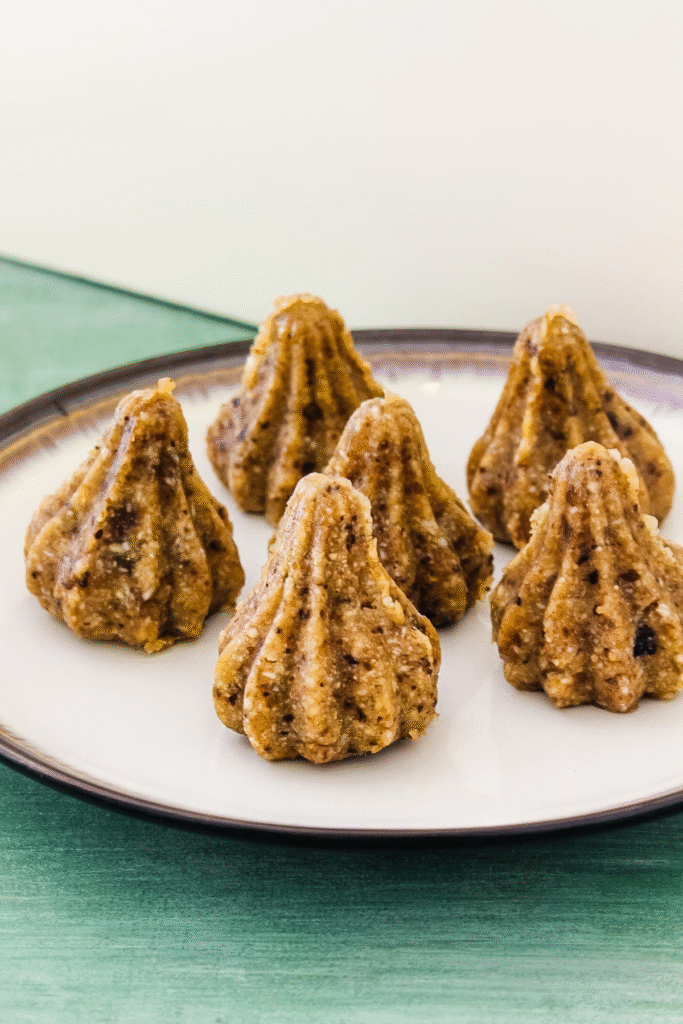
Wholesome, flavorful, and festive, they require no cooking and come together in minutes! No added sugar, no cooking hassle—just pure goodness shaped into festive bites! Whether you’re celebrating Ganesh Chaturthi with traditional sweets or looking for a nutritious prasad option, these dry fruit modaks are a must-try. Their rich flavor and melt-in-the-mouth texture are sure to please Lord Ganesha and your family alike. Plus, they make for a wonderful homemade gift or snack any time of the year!
❤️ You’ll Love This Dry Fruits Modak
- This delightful modak recipe is a lifesaver when you’re short on time. It takes just about 10 minutes from start to finish, making it perfect for busy festive days like Ganesh Chaturthi. The best part? No cooking involved! All you need is a good food processor or blender — simply combine the ingredients, blend them into a sticky mixture, and shape into modaks. That’s it!
- What makes this recipe extra special is that it’s naturally sweetened — there’s no added sugar. The sweetness comes purely from wholesome ingredients like soft dates and juicy raisins, making it a healthier choice compared to traditional sweets loaded with refined sugar. You get the same indulgent taste, without the guilt.
- This year, why not offer something different to Lord Ganesha — a nutritious, no-cook modak made with love, purity, and clean ingredients? Amidst the many elaborate sweets and deep-fried snacks that usually fill the prasad thali, this modak stands out for its simplicity and nourishment.
- We know how hectic the day can get — between decorating the pandal, preparing multiple dishes, organizing aarti, and welcoming guests — and that’s exactly where this recipe shines. It’s a quick, fuss-free option that still feels festive and traditional.
- And don’t worry if you don’t have a modak mould on hand. You can easily roll the mixture into ladoos instead. They’ll taste just as delicious and be equally loved by your family and by Bappa himself.
- So, if you’re looking for a last-minute sweet that is both easy and healthy, this dry fruit modak is the perfect choice!
🧾 Ingredient Notes
Take a look at this simple ingredient spread—just 6 wholesome ingredients are all it takes! In minutes, you’ll have nutritious, flavorful dry fruits modaks ready to serve as a divine offering to Lord Ganesha.
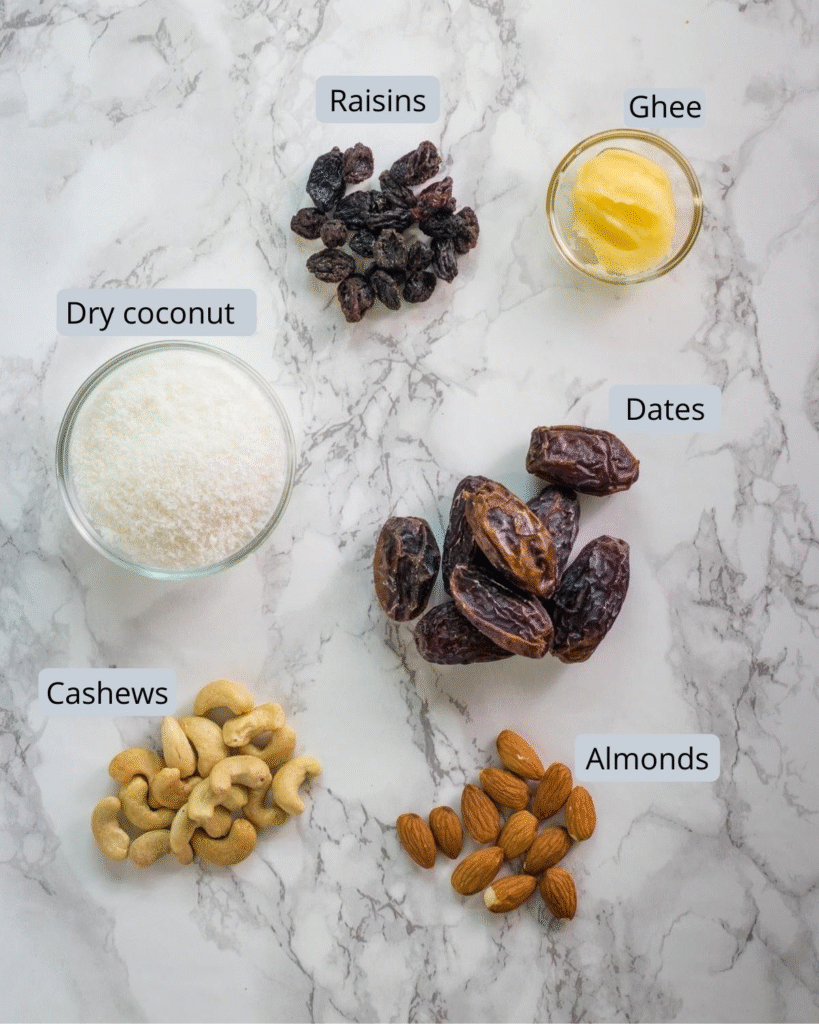
- Nuts: For this recipe, I have chosen a classic combination of almonds and cashews, as they are the backbone of many traditional Indian mithais. Their rich, buttery flavor and slightly crunchy texture add depth and body to the modaks. However, feel free to get creative and make your own nut blend. You can incorporate walnuts for their earthy flavor, pecans for a slightly sweet and buttery touch, or even hazelnuts for a distinct nutty aroma. If you’re aiming for a nutrient-rich version, toss in a few pistachios or Brazil nuts. Just make sure to lightly roast all the nuts beforehand for enhanced flavor and better texture.
- Dates: I have used California Medjool dates, which are known for their large size, natural sweetness, and soft, chewy texture. They blend beautifully with the nuts without needing much moisture. These dates are much juicier compared to the smaller, drier Indian varieties that are often stickier and less plump. If you’re using local Indian dates or other drier types, you might want to soak them in warm water for 10–15 minutes to soften them before blending. This helps create a smoother, more cohesive mixture for shaping modaks.
- Water (optional): In my preparation, I added just a splash of water—only because my dates were slightly firm. Whether you need water at all depends entirely on the moisture content of your dates. If they’re soft and fresh, you might be able to skip the water entirely. But if they’re on the drier side, adding a teaspoon or two of warm water (or even milk for added richness) can help bind everything together without making the mixture too sticky.
- Ghee: A small amount of desi ghee adds not just richness but also that traditional festive aroma we all associate with Indian sweets. Ghee is a staple in Indian dessert-making due to its flavor, satiety, and spiritual significance in offerings like modak for Lord Ganesha. However, if you’re making these modaks for someone following a vegan diet, simply replace ghee with cold-pressed coconut oil. Coconut oil not only helps bind the mixture but also lends a tropical aroma that pairs wonderfully with dates and nuts.
👩🍳 How To Make Dry Fruits Modak? (Pics)
NOTE: I’ve prepared this recipe using a traditional Indian-style mixer grinder (specifically, a Preethi brand). High-powered blenders like Vitamix or Blendtec are not ideal for this method, as they function differently and may not give the desired texture. If you don’t have an Indian mixer grinder, a food processor would be a better alternative to achieve similar results.
1) Take almonds and cashews in the mixer jar: Start by placing raw almonds and cashews into a dry mixer grinder or food processor. These wholesome nuts create the foundation of your modak, lending a delightful crunch and a naturally rich, nutty flavor that elevates the overall taste. Make sure the nuts are clean and dry, without any moisture.
2) Pulse to grind into a coarse powder: Now pulse the nuts a few times until you get a coarse, grainy texture. Avoid over-blending as you don’t want a fine powder or nut butter — the texture should be slightly chunky so that the modak retains some bite.
3) Add dates and raisins: Next, add soft pitted dates and sweet golden or black raisins to the same jar. Dates act as a natural sweetener and binding agent, while raisins add an extra burst of flavor and moisture. If your dates are a bit dry, soak them in warm water for a few minutes and pat dry before using.
4) Add grated dry coconut: Now sprinkle in grated or shredded dry coconut. This adds a beautiful aroma and a slightly chewy texture to the mixture, enhancing the traditional flavor of Indian sweets. If using desiccated coconut, ensure it’s unsweetened and fresh.
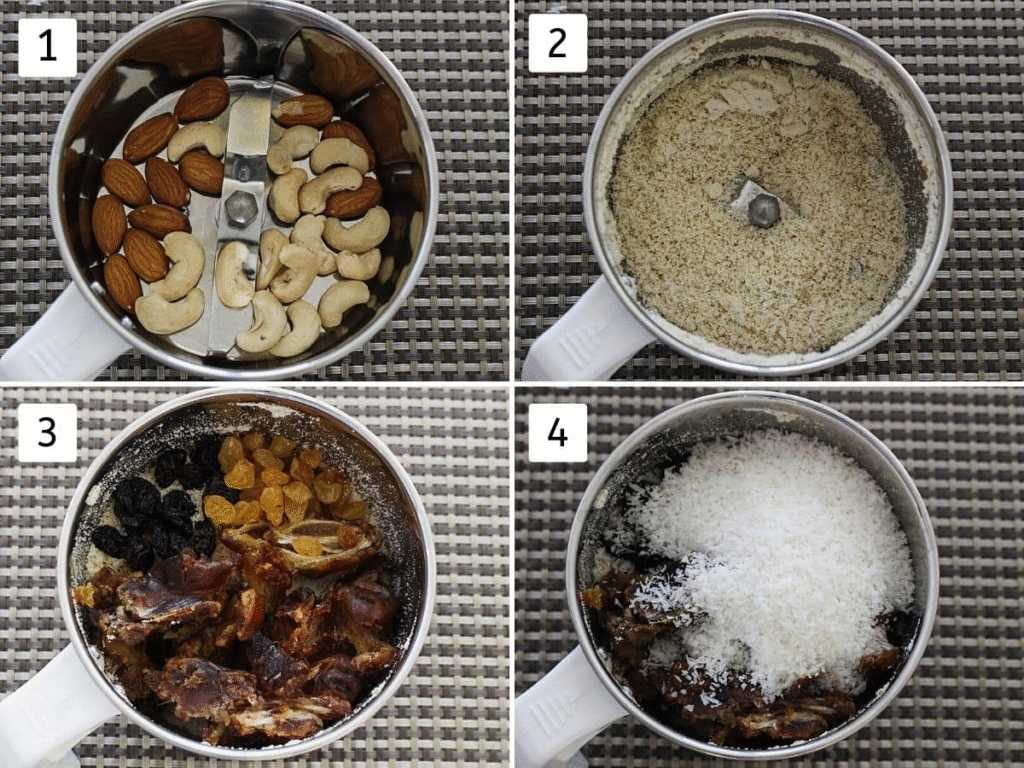
5) Pulse again to combine: Pulse everything again in short bursts until the mixture turns into a coarse, sticky blend. The mixture should start to clump together slightly when pressed between your fingers. Be sure not to over-process; we still want a textured consistency.
6) Add a spoonful of ghee: Now add a spoon of warm, melted ghee (clarified butter). This not only adds richness but also helps in binding the mixture together. Ghee also gives the modaks a smooth texture and traditional taste.
7) Pulse until the mixture comes together like dough: Pulse the mixture once more. At this stage, it should start coming together into a soft dough-like consistency. If the mixture still feels dry or crumbly, add a teaspoon of water or a few more drops of ghee at a time, pulsing between additions, until it holds its shape when pressed.
8) Shape the mixture into modak using a mould Transfer the prepared mixture to a plate. Grease your modak mould lightly with ghee to prevent sticking. Keep the mould closed and fill it from the bottom opening — take a small portion of the mixture and press it tightly from the bottom hole.
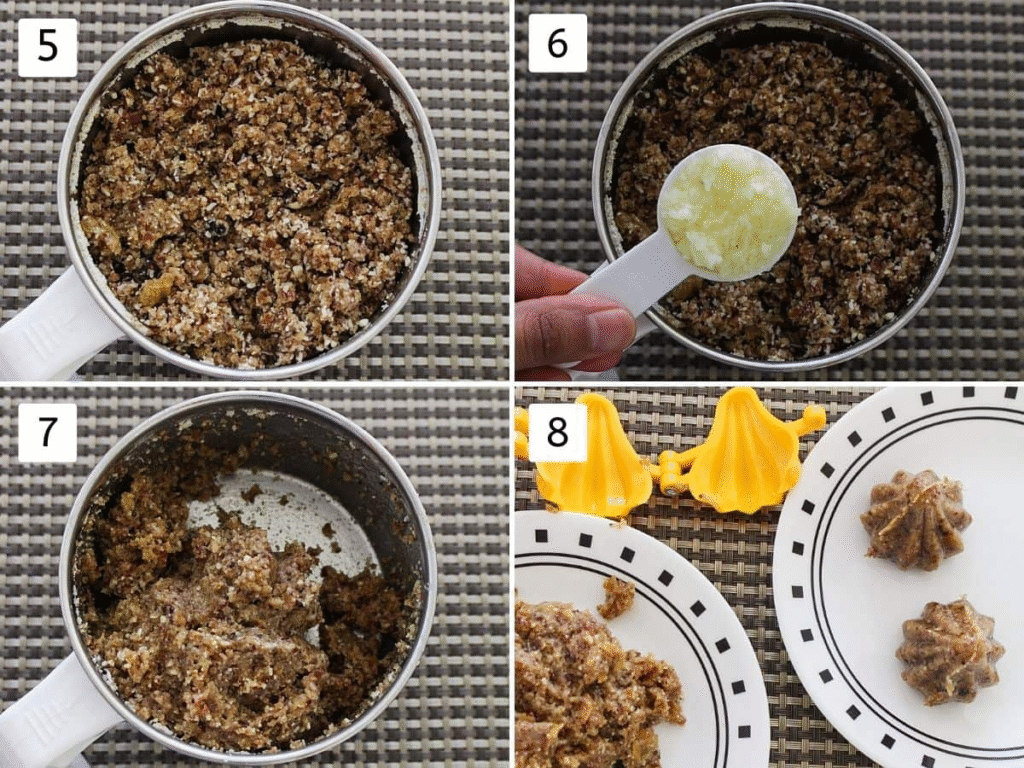
💭 Tips For Dry Fruits Modak Recipe
- Gently shape the mixture into bite-sized balls to form delicious, energy-packed ladoos. These nutritious bites are perfect for growing children and make a wholesome after-school treat.
- There’s also a different variation of dry fruit modak where the filling consists of finely chopped nuts and dried fruits, while the outer shell is made with rice flour dough. This version closely resembles the traditional ukadiche modak. The method of preparing the rice flour covering, shaping the modaks, and then steaming them remains the same as the classic recipe.
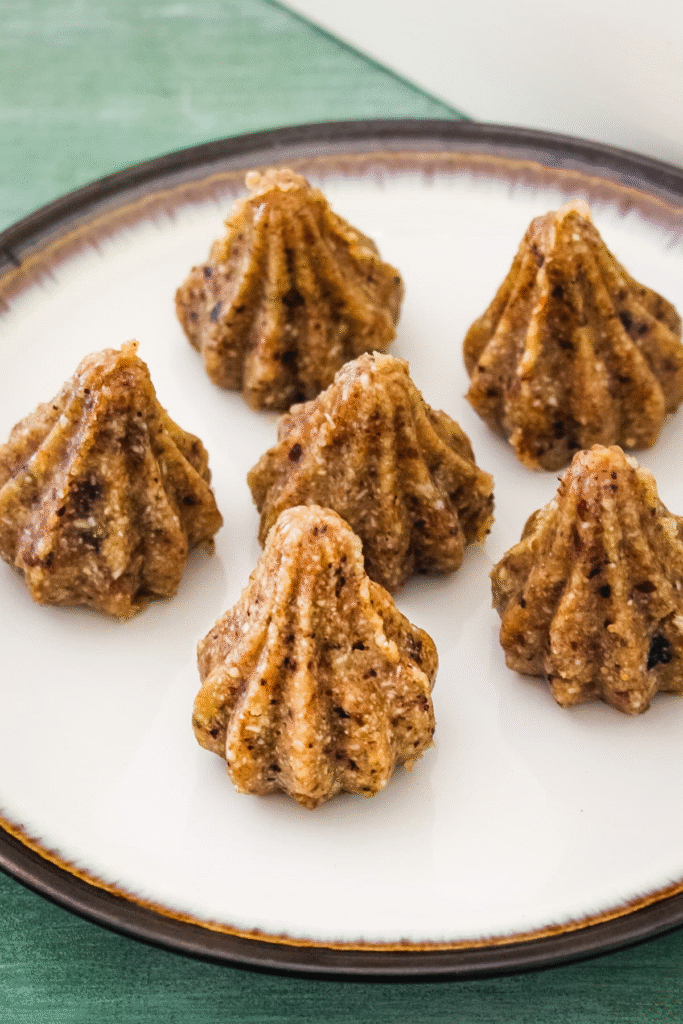
Notes
Note on Equipment:
For this recipe, I’ve used an Indian-style Preethi brand mixer grinder, which is specifically designed to handle small quantities of ingredients and offers better control for coarse blending. Blenders like Blendtec or Vitamix, while powerful, are not ideal for this particular preparation, as they tend to over-process the mixture into a paste instead of the desired coarse texture. If you don’t have access to an Indian-style grinder, a food processor is your best alternative. It allows better pulsing and control, helping you achieve the perfect consistency without turning the ingredients mushy.
No Modak Mould? No Problem!
If you don’t have a traditional modak mould on hand, don’t let that stop you from making this festive treat. Simply take small portions of the mixture and roll them between your palms to form round ladoo shapes. They may not have the signature modak appearance, but they’re just as delicious and equally auspicious for offerings during Ganesh Chaturthi. In fact, shaping them by hand adds a personal and heartfelt touch to your homemade sweets.
